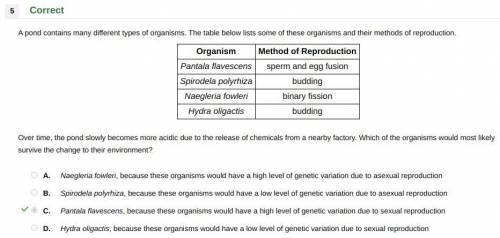
A pond contains many different types of organisms. The table below lists some of these organisms and their methods of reproduction.
Organism Method of Reproduction
Pantala flavescens sperm and egg fusion
Spirodela polyrhiza budding
Naegleria fowleri binary fission
Hydra oligactis budding
Over time, the pond slowly becomes more acidic due to the release of chemicals from a nearby factory. Which of the organisms would most likely survive the change to their environment?
A. Naegleria fowleri, because these organisms would have a high level of genetic variation due to asexual reproduction
B. Spirodela polyrhiza, because these organisms would have a low level of genetic variation due to asexual reproduction
C. Pantala flavescens, because these organisms would have a high level of genetic variation due to sexual reproduction
D. Hydra oligactis, because these organisms would have a low level of genetic variation due to sexual reproduction
C. Pantala flavescens, because these organisms would have a high level of genetic variation due to sexual reproduction
I hope this helps.


Answers: 2


Another question on Biology


Biology, 22.06.2019 02:40
What advantage does a crop that undergoes vegetative reproduction have over plants that start from the seed? 1points a they store nutrients. b they can travel farther. c they experience more genetic variation. d they only occur in high-resource environments.
Answers: 1

Biology, 22.06.2019 03:00
To answer this question, researchers studied populations of the dusky salamander (desmognathus ochrophaeus) living on different mountain ranges in the southern appalachian mountains. the researchers tested the reproductive isolation of pairs of salamander populations by leaving one male and one female together and later checking the females for the presence of sperm. four mating combinations were tested for each pair of populations (a and b)—two within the same population (female a with male a and female b with male b) and two between populations (female a with male b and female b with male a). the proportion of successful matings for each mating combination was measured. for example, when all the matings of a particular combination were successful, the researchers gave it a value of 1; when none of the matings were successful, they gave it a value of 0. then the researchers calculated an index of reproductive isolation that ranged from 0 (no isolation) to 2 (full isolation). the reproductive isolation value for two populations is the sum of the proportion of successful matings of each type within populations (aa + bb) minus the sum of the proportion of successful matings of each type between populations (ab + ba). the table provides data for the geographic distances and reproductive isolation values for 27 pairs of dusky salamander populations.
Answers: 1

You know the right answer?
A pond contains many different types of organisms. The table below lists some of these organisms and...
Questions

Mathematics, 05.02.2020 10:56

Mathematics, 05.02.2020 10:56

Mathematics, 05.02.2020 10:56



Business, 05.02.2020 10:56

Mathematics, 05.02.2020 10:56


History, 05.02.2020 10:56

Chemistry, 05.02.2020 10:56

Mathematics, 05.02.2020 10:56

Mathematics, 05.02.2020 10:57

Business, 05.02.2020 10:57

Mathematics, 05.02.2020 10:57

English, 05.02.2020 10:57



Mathematics, 05.02.2020 10:57

Mathematics, 05.02.2020 10:57



